Here is an article on Fake or Fortune by Katy Prickett for the BBC.
https://www.bbc.co.uk/news/articles/cj4w997lpz7o
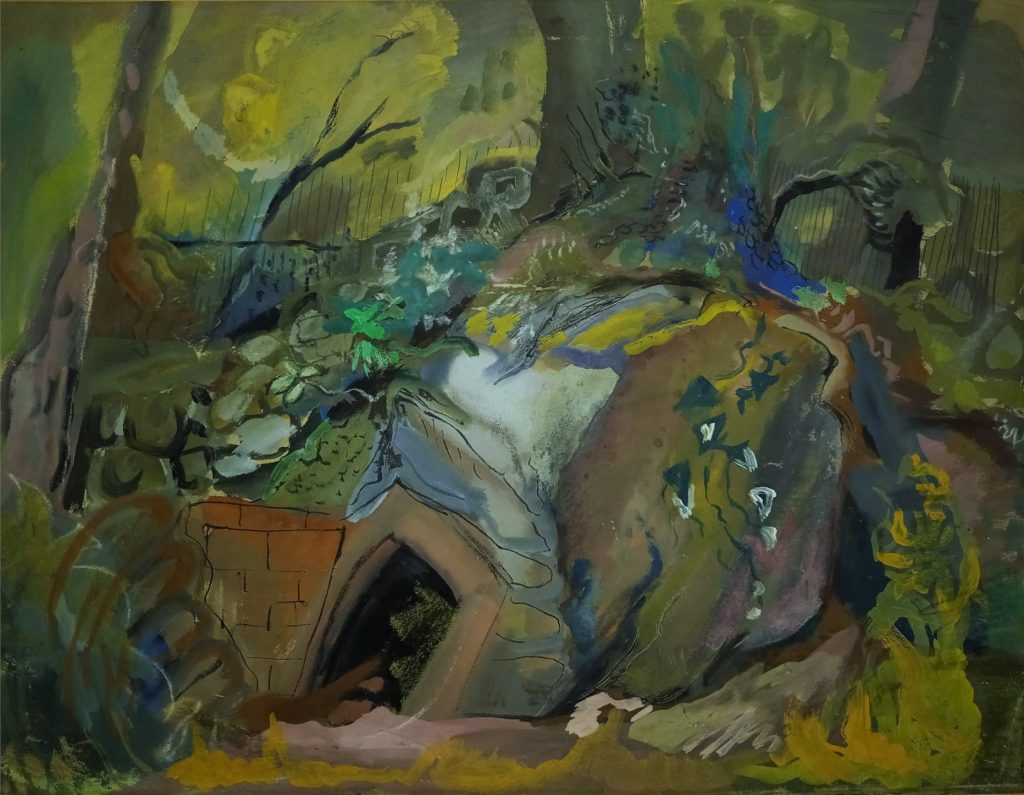
Here is an article on Fake or Fortune by Katy Prickett for the BBC.
https://www.bbc.co.uk/news/articles/cj4w997lpz7o

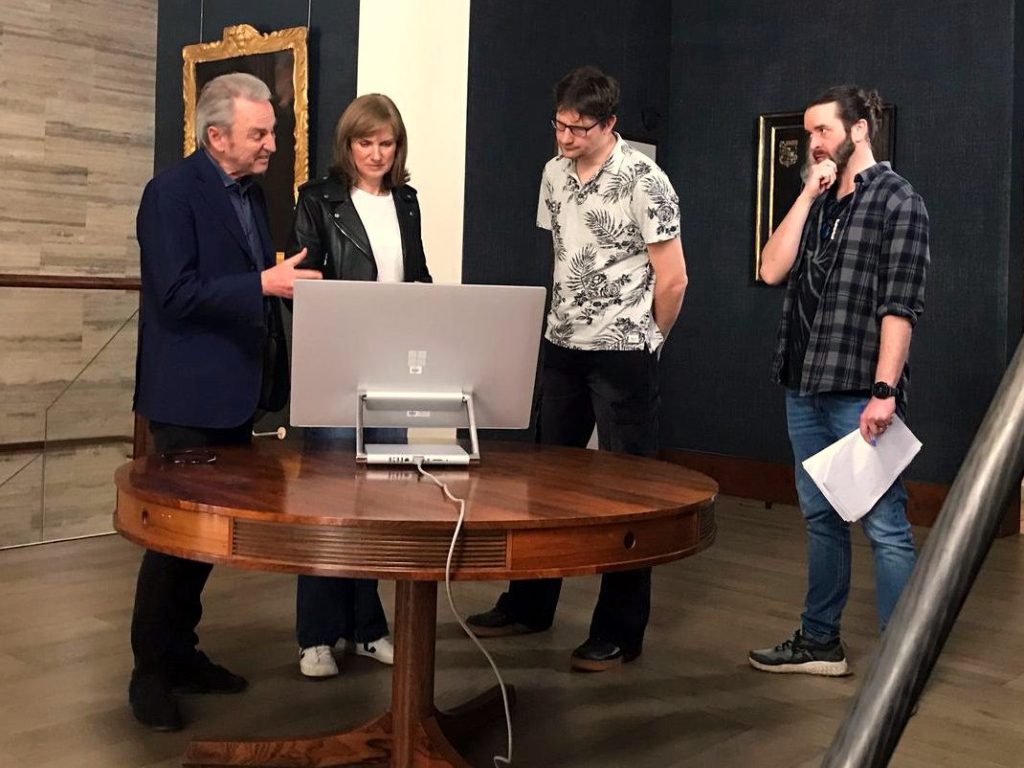
As some of you may know I am a contestant on the BBC show Fake or Fortune on the 4th August 2025 at 9pm. The iPlayer link is here with a bit more information on the show. You will have to find out if it’s a win or a dud. Either way, little money was lost.
Fiona Bruce and art expert Philip Mould investigate a potential missing work by trailblazing New Zealand-born modernist artist Frances Hodgkins that was bought for just £35 at an auction. The current owner believes it was painted for a post-war scheme called Pictures for Schools, that was intended to place works of art in classrooms to inspire pupils – which may have led to it being mistaken for a student’s work
My new book on Nan Youngman and Pictures for Schools is out now!
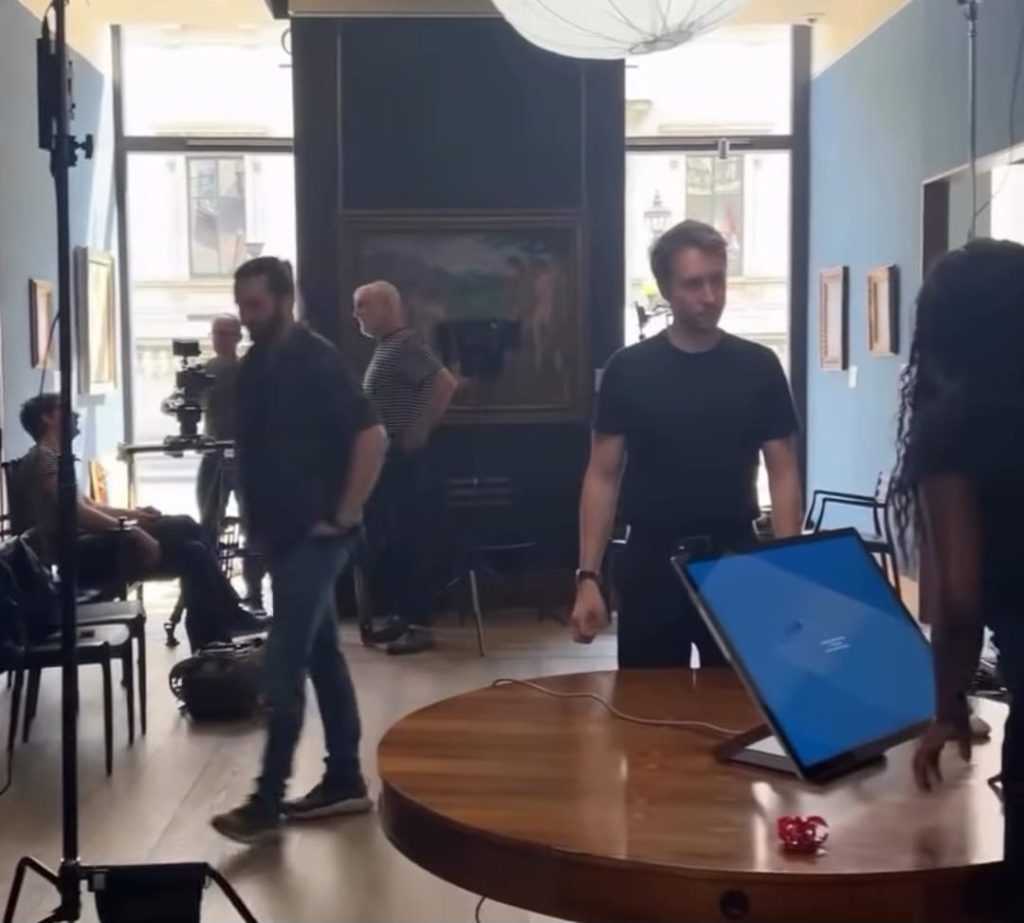
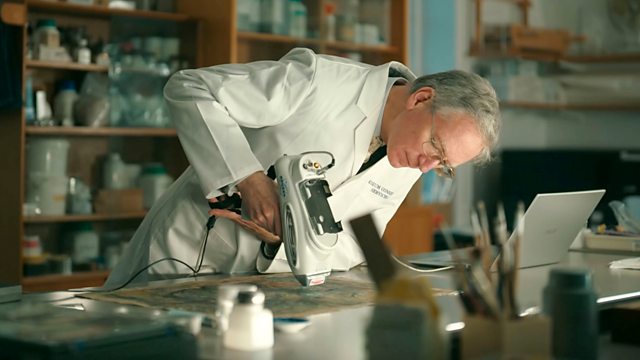
I have put some paintings of Julia Balls in an exhibition at the Gallery Above, Linton, Cambridge. 94 High St, Linton, Cambridge. The exhibition is small but a celebration of the life of Julia Ball, before a larger non-selling exhibition comes to Cambridge in a few months.
July 23rd to August 16th 2025
Opening hours 10:00 – 5:00 – Wednesdays to Saturdays
Julia Ball was born in Devon in 1930, and studied at the School of Art at Reading University where she studied printmaking. A lot of her early career was in printmaking and illustration. She then moved to Cambridge, teaching at the school of art and then became an examiner in the 1970s working with Warwick Hutton marking work. There were a large amount of prints made during the 1960s, of abstract architectural details and seascapes and she would also let other local artists use her printing presses to produce their work.
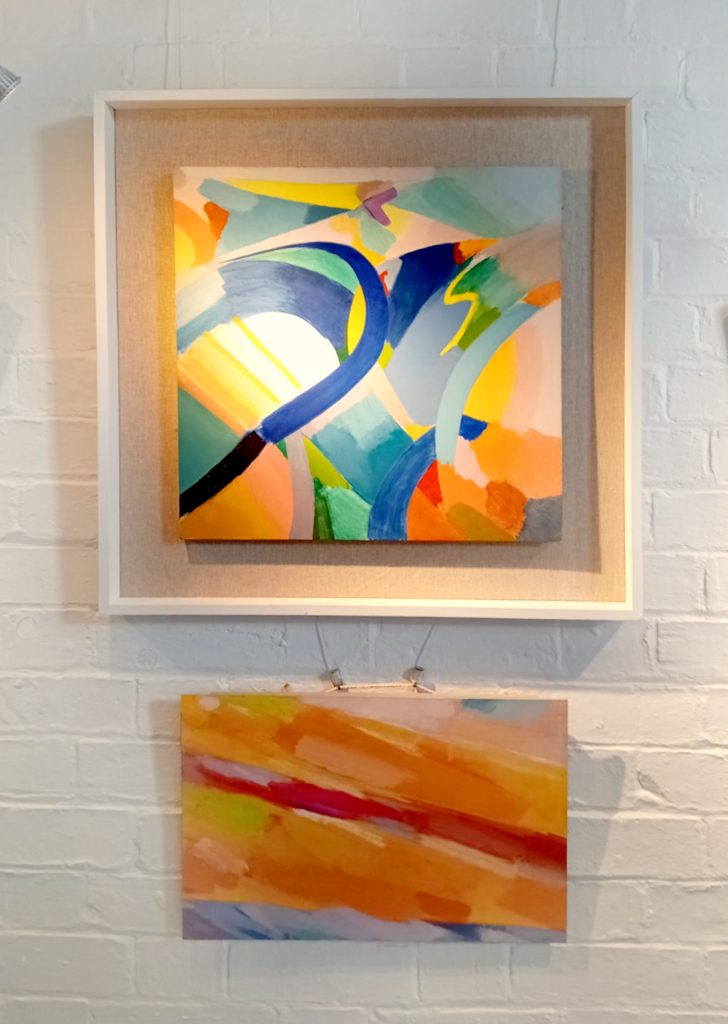
In Cambridgeshire Ball became friends with Nan Youngman and joined the Painters and Sculptors society. Early members where Cecil and Elisabeth Collins, Bettie Rea, and Elisabeth Vellacott. In this company and with Nan’s natural talent as a promoter from her years running the Pictures for Schools exhibitions, she helped make many of the local artists well known.
Julia’s work is deliberately atmospheric and to those familiar to her work, one gets to see the locations and places that became staples in her work. Places inspired her works in different ways, from the reeds and water pools and ditches of the Cambridgeshire Fens, to the beaches and dunes of North Norfolk.
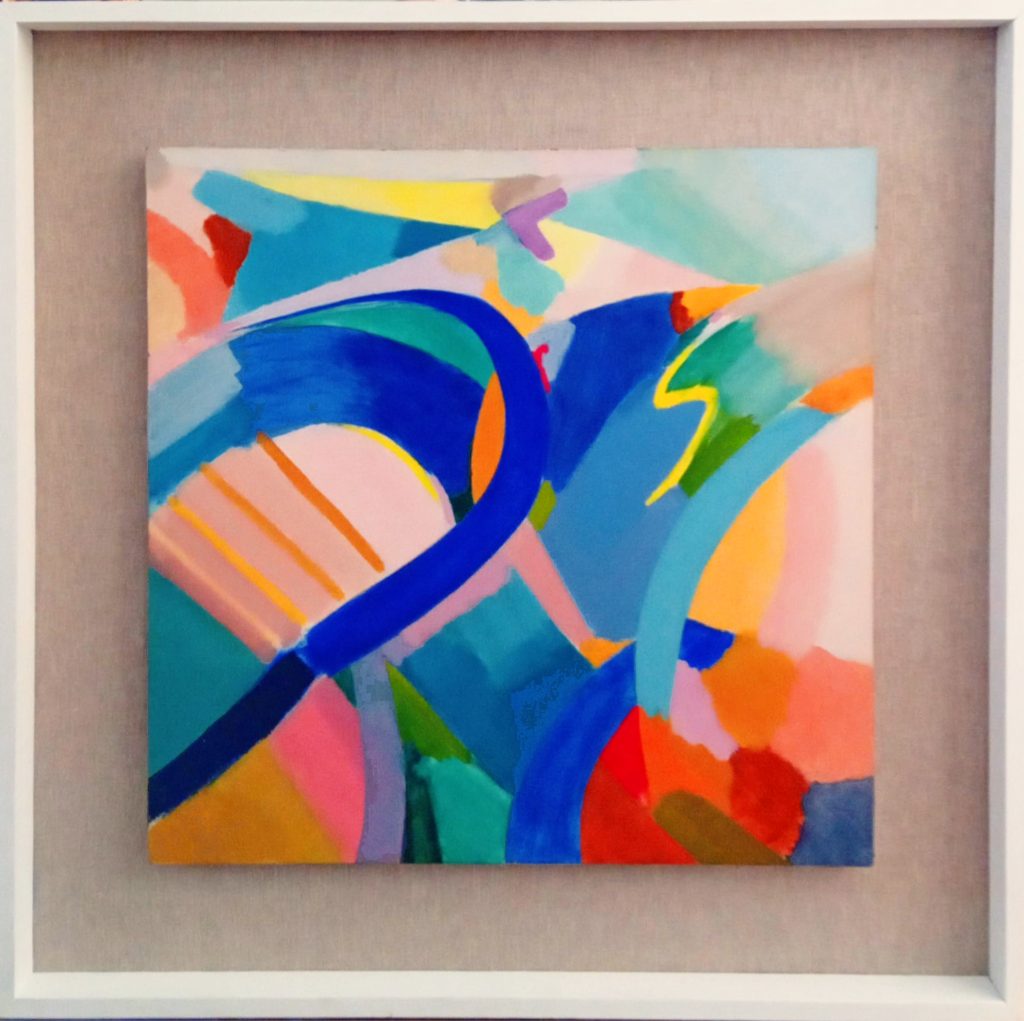
Many of the Cambridge artists would holiday and paint plein air on the North Norfolk coast and Youngman used to take painting holidays there with friends. Some of Balls early painted works can be seen of beaches and dunes around Brancaster and Titchwell.
Ball then started to use the flatness of the landscape around Cambridge in a series of abstract colourful landscapes, partially in the fens. Into the 1980s, these landscapes were focused on the fenland waterways of Wicken Fen and Quy Fen showing the long ditches and fields in all weather conditions throughout the year. Ball would work painting watercolours and then taking them to her studio to be worked up into larger pieces. Throughout her career she has always used a very similar palate of colours that are mixed when painting.
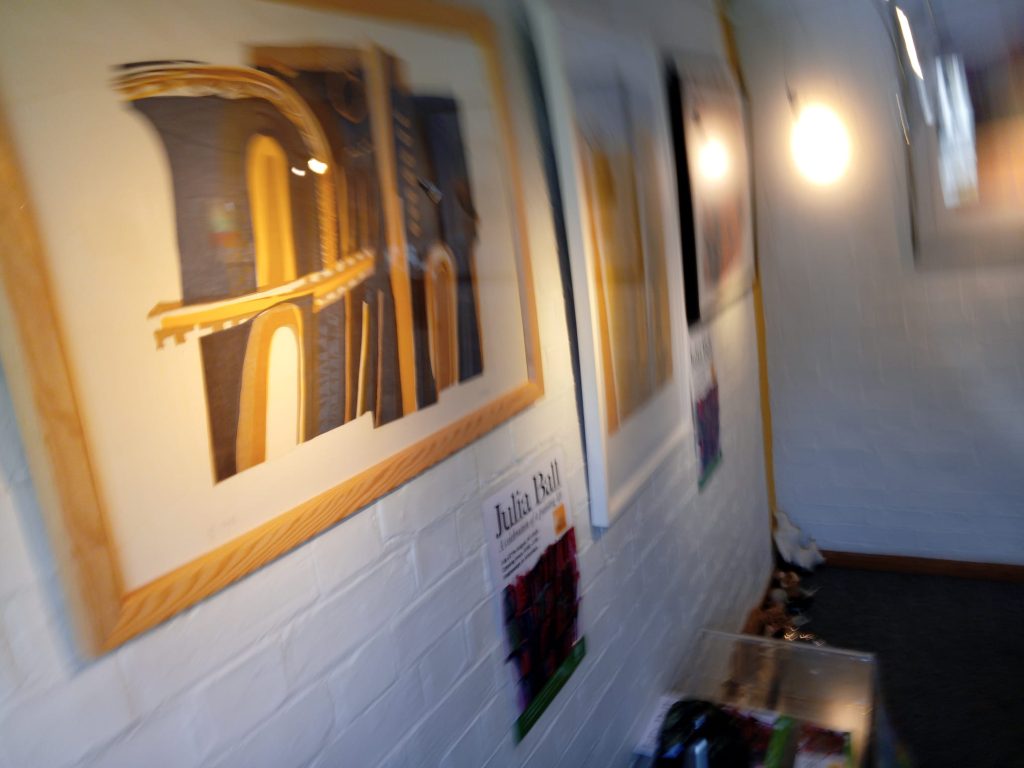
In 1983 she visited the Greenham Common anti nuclear women’s camp. When asked many years later about her feelings she said “It was also a place where I think … you didn’t talk about it very much unless people asked you. It wasn’t something that you could personally claim pride in. I mean, I know, I thought I had to be careful, not careful, but I was aware that it was something deeper than that. You weren’t just being a heroine, or hero, it was more fundamental. And that sort of boasting about it would be detrimental to the whole thing. It wasn’t boasting, it was just part of your life.
Over her life she had many exhibitions, most notably including at the Bluecoat Gallery – Liverpool, 1978; Kettle’s Yard – Cambridge, from 1980 with the Cambridge Society of Painters and Sculptors; Karen Wright’s Hobson Gallery, 1982, University of Nottingham, 1986; New Hall College, Heffer’s Gallery and the Lynne Strover Gallery, Fen Ditton in 1994.
Below are some photos from Julia Ball’s studio in Cambridge – The house has now been sold and redeveloped.
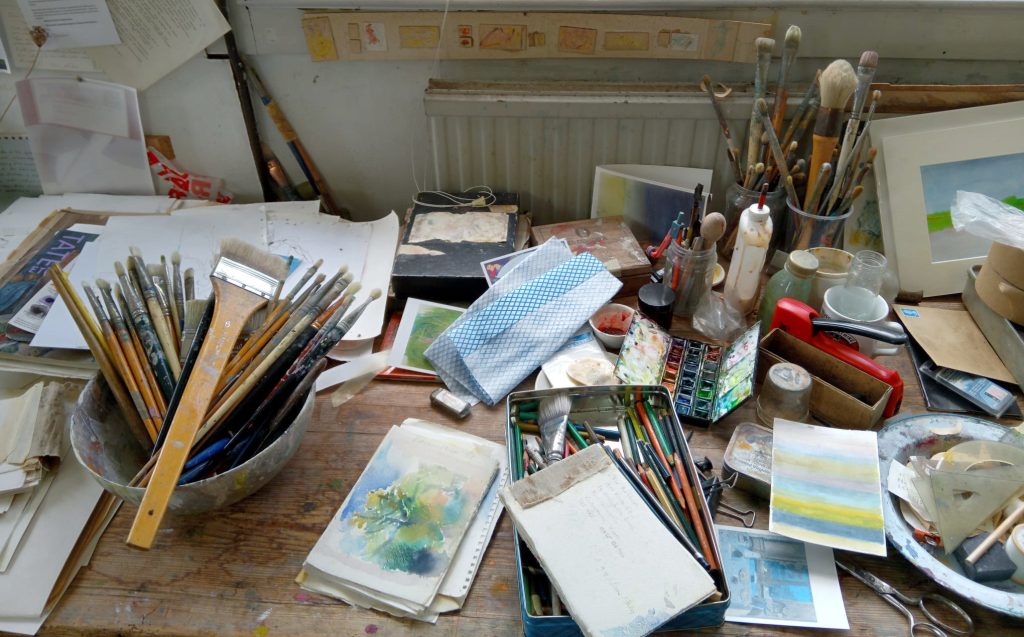
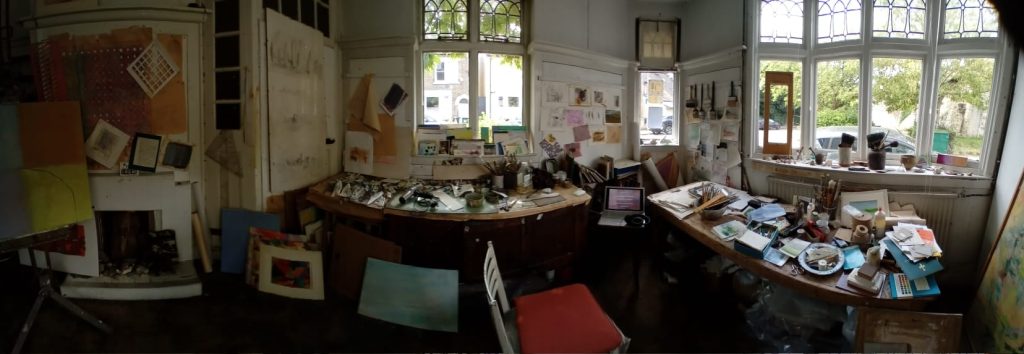
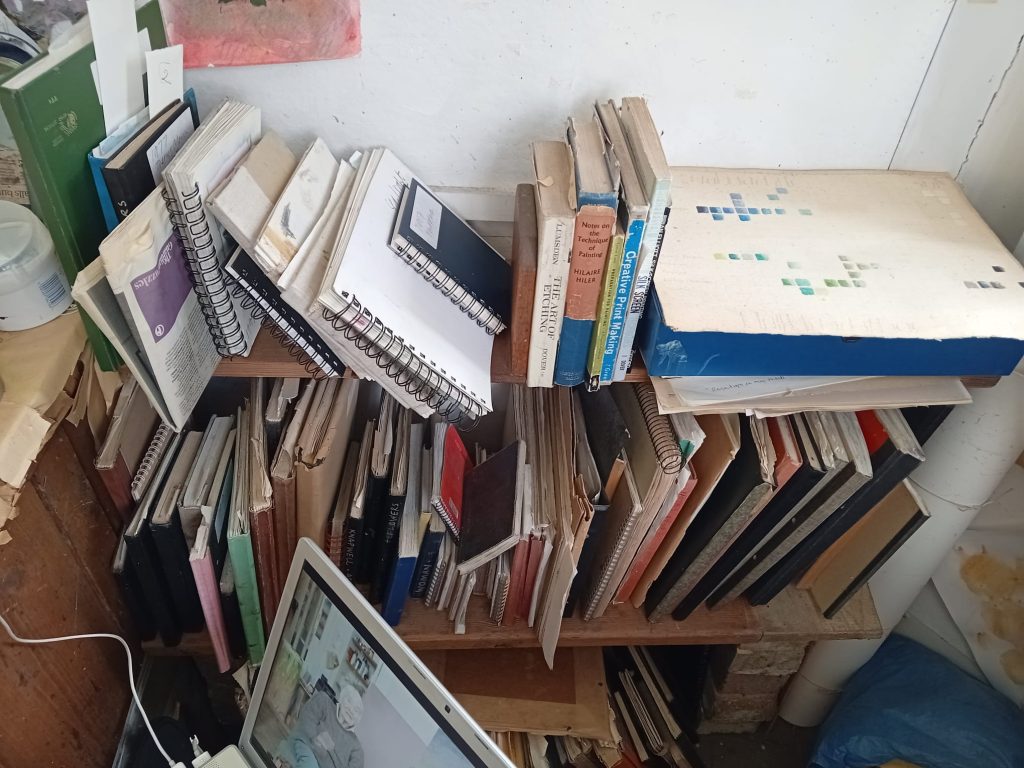
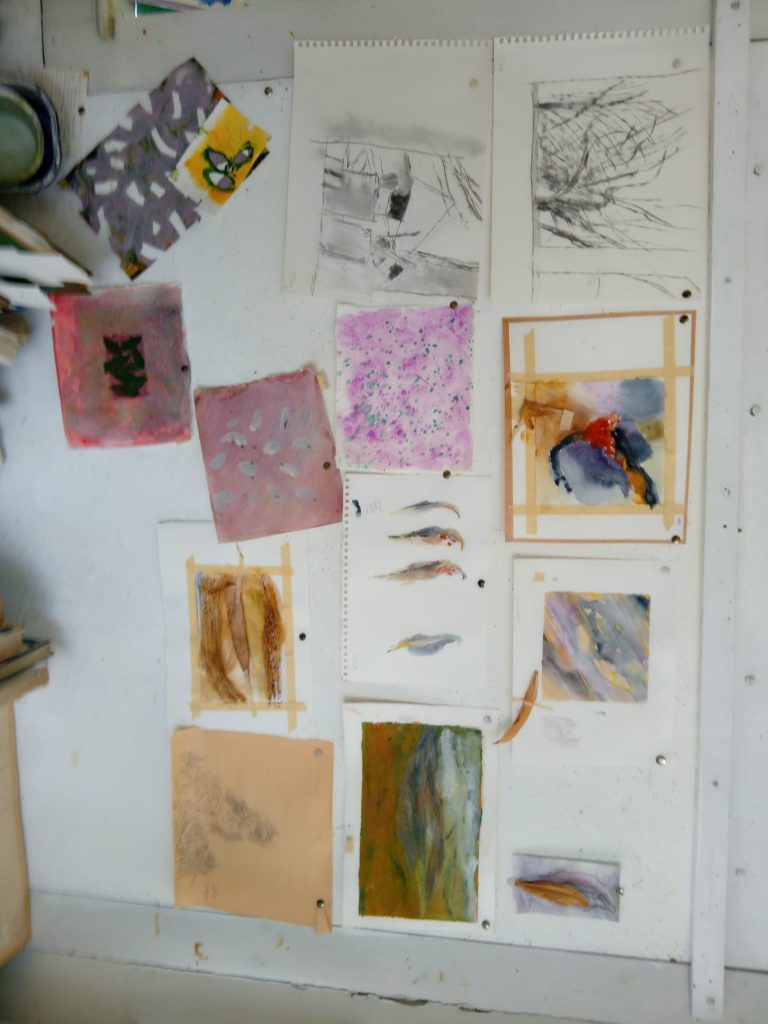
The photograph below is by John Deakin and the painting is by Francis Bacon. The car in the background appears in the painting too and shows the painters model, Isabel Rawsthorne. Deakin was one of Francis Bacon’s friendships that survived his rages and drunken antics. He is now remembered for his street photography of London life but in his time he worked
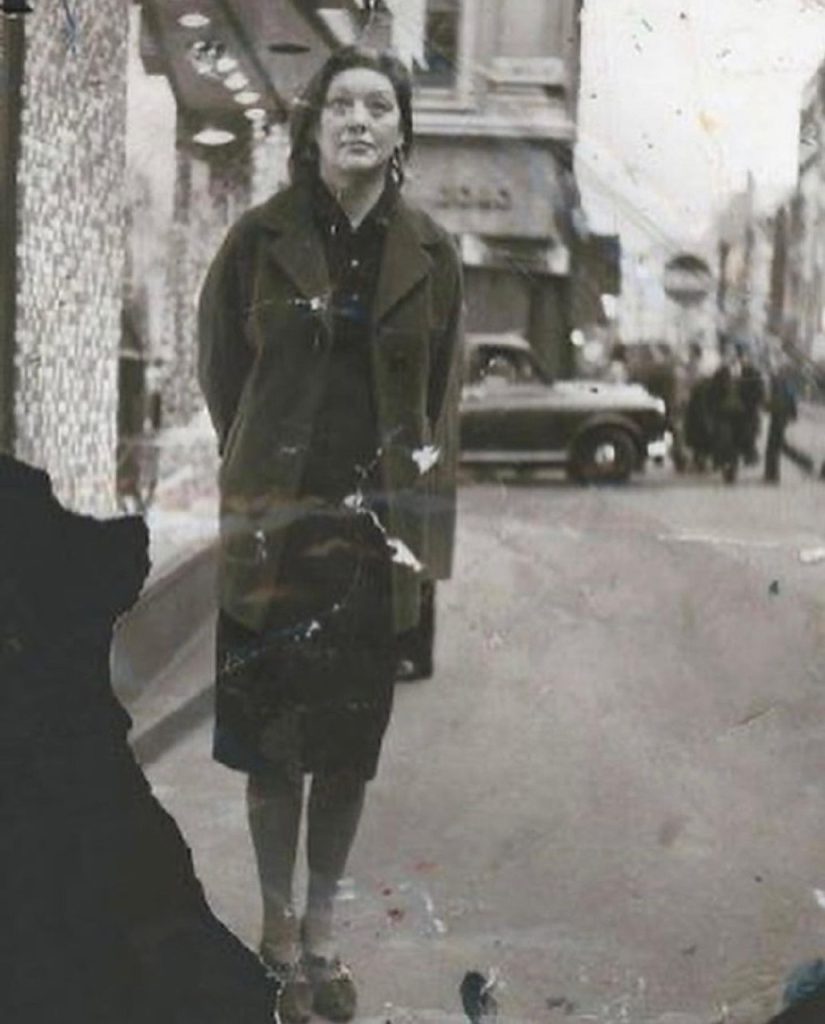
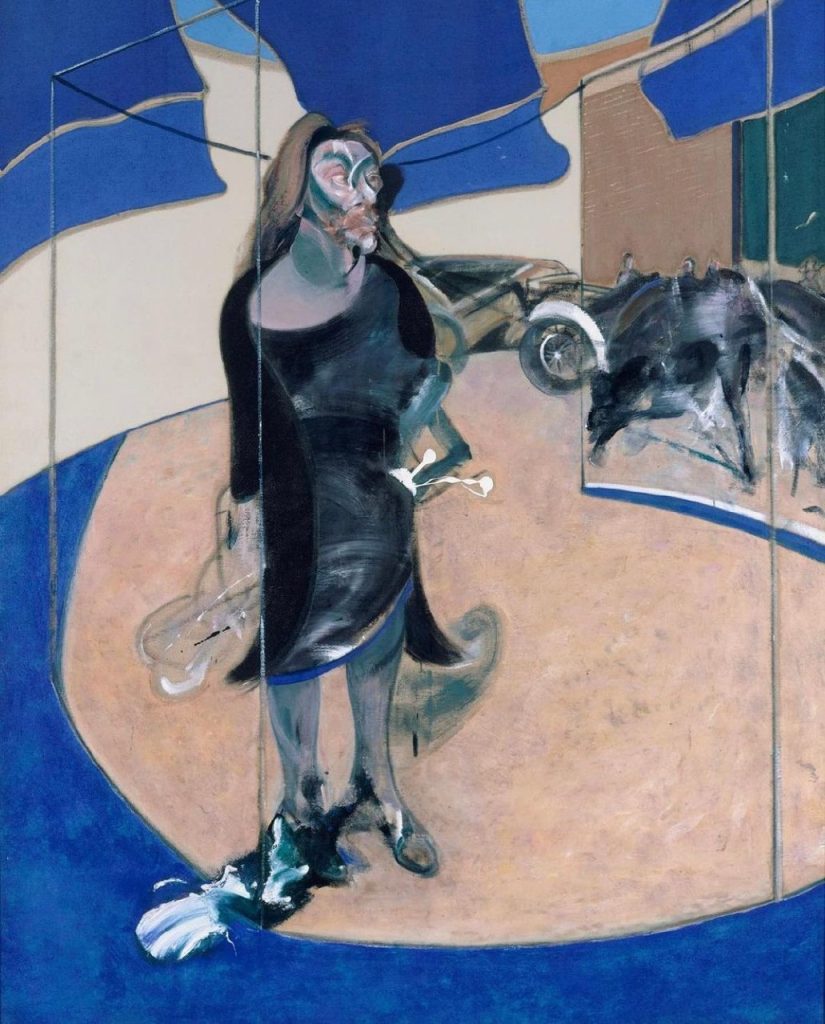
Isabel Rawsthorne was an artist and friend of Bacon and they had known each other since the late 1940s. Rawsthorne attended Liverpool Art School and won a scholarship to the Royal Academy Schools. In London, she met Jacob Epstein, entered his household as a studio assistant and modelled for him. Determined to be an artist in her own right, she left London for Paris. In 1935, she met Alberto Giacometti and they became close friends, resulting in the first sculpture bust of her made in 1936. Isabel’s remarkable beauty was both an asset and a distraction from her own quest to become an artist and she frequently gained the attention of other artists who wished to paint her, notably Andre Derain and Pablo Picasso who both painted multiple portraits of her in 1936.
During the Second World War she worked in intelligence and black propaganda for a clandestine department of the British government. After the war, she briefly returned to Paris before settling in London and subsequently met Bacon and they became friends. They may well have met at the famous private members club The Gargoyle which was still popular with artists and writers in post-war London. Or perhaps they were introduced to each other by Erica Brausen of the Hanover Gallery, where both artists showed in the late 1940s.
Bacon used photographs taken by John Deakin as source material rather than working from life. He commented to David Sylvester that, ‘I find it easier to work than actually having their presence in the room’.
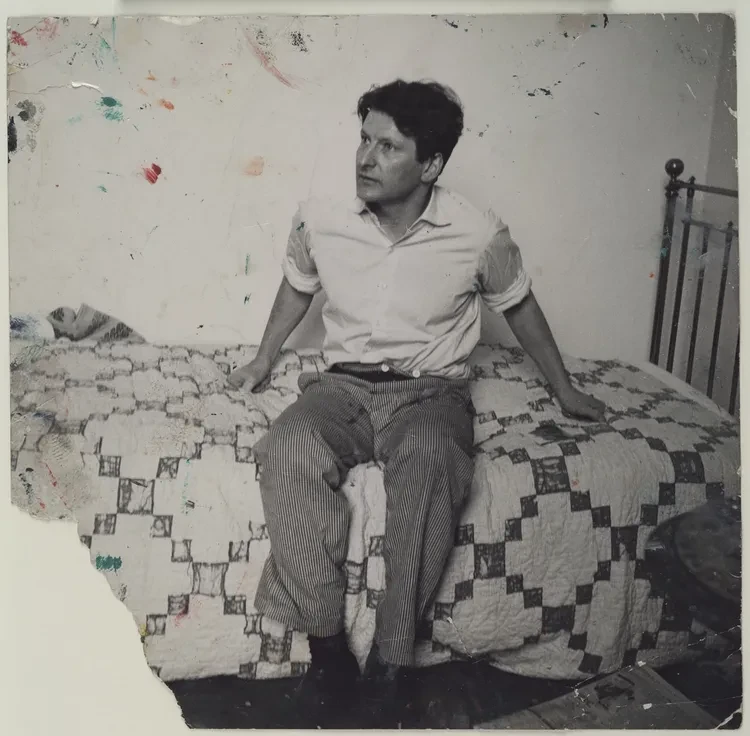
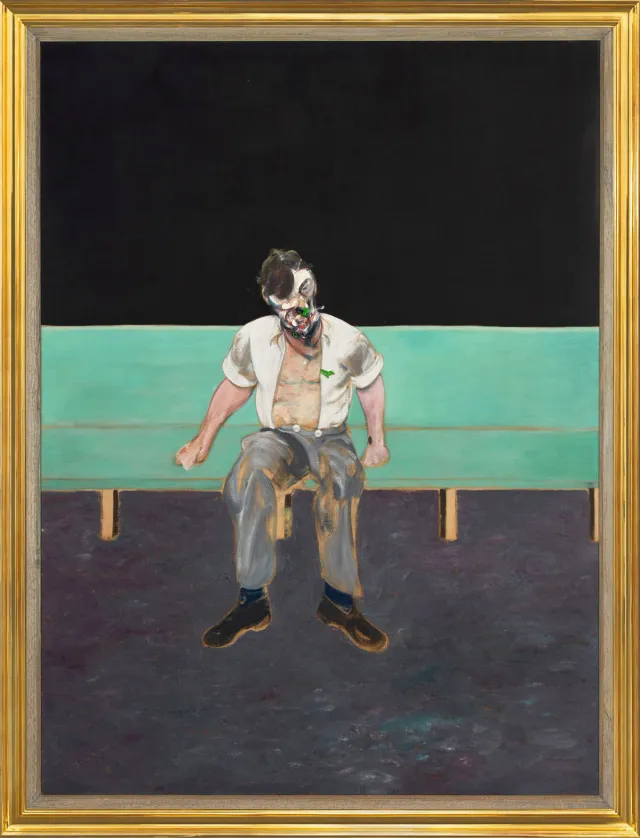
The American artist Kathleen Ryan works with glass and plastic beads to make beautiful sculptures of rotten fruit. Born in 1984 her work is exceptional.
Ryan composes her sculptural installations in a variety of materials from cast iron and precious stones, to found objects including bowling bowls. The artist has a pre-occupation with natural forms, juxtaposed with industrial manufacture, and alongside motifs which reference the classical sculptural tradition and the artist’s interest in archaeology.
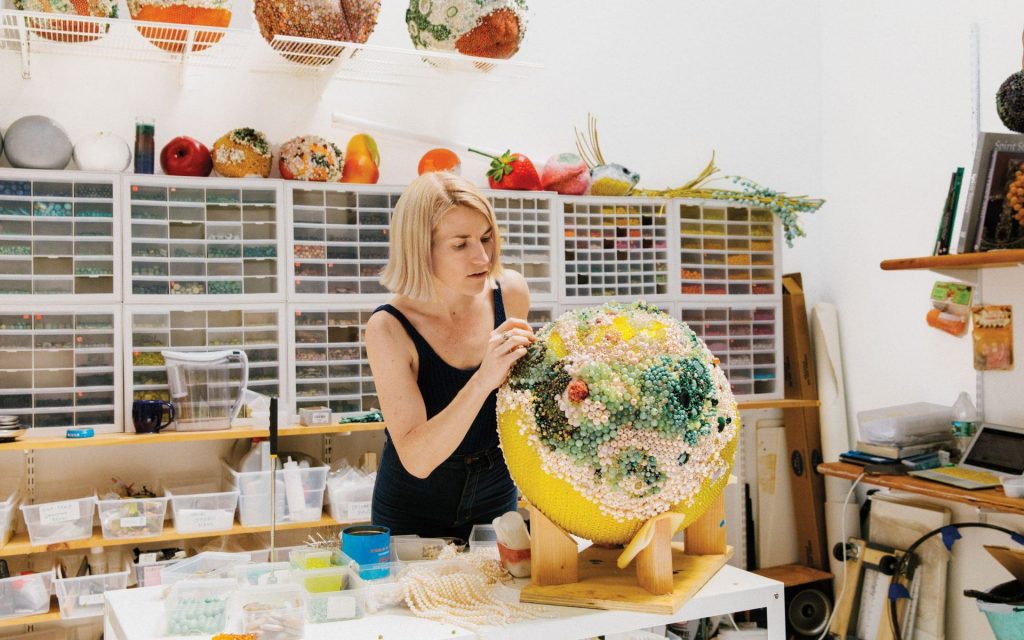
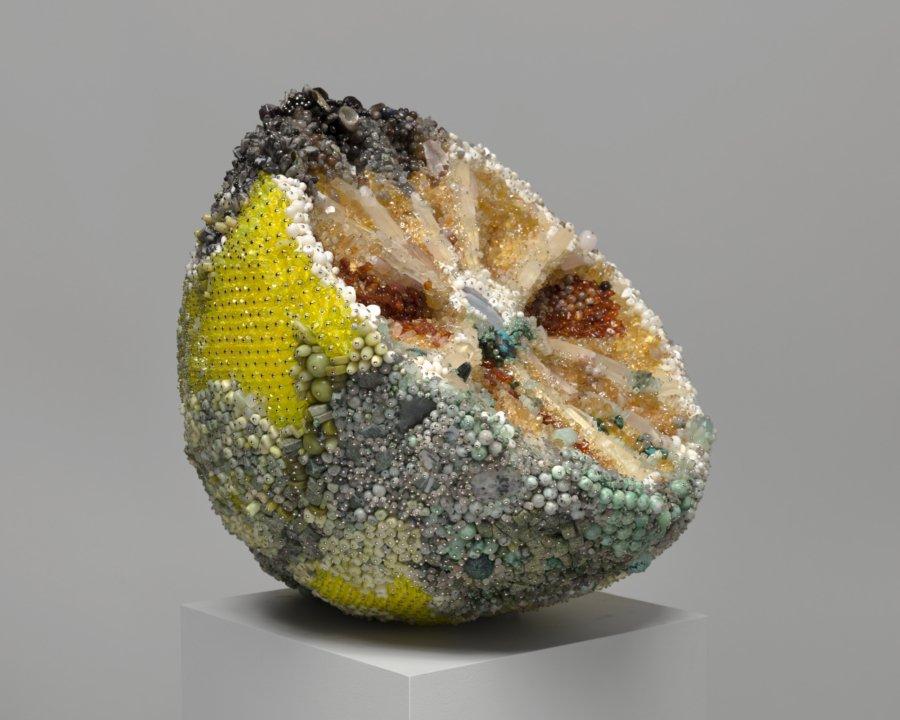
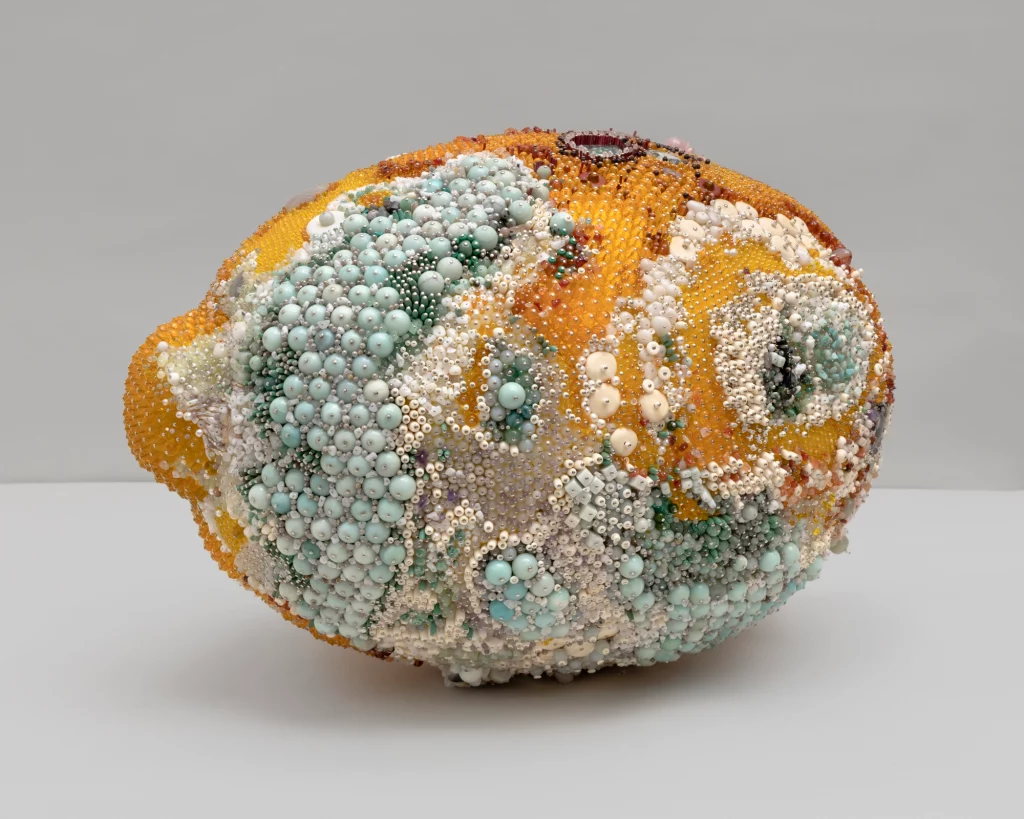
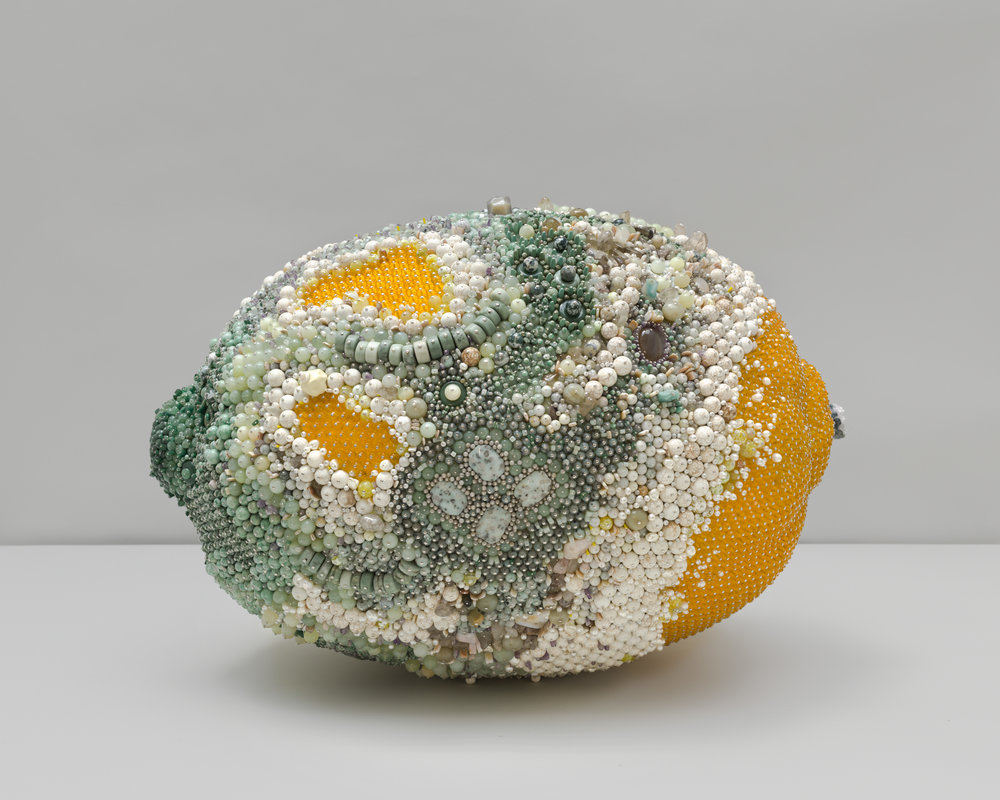
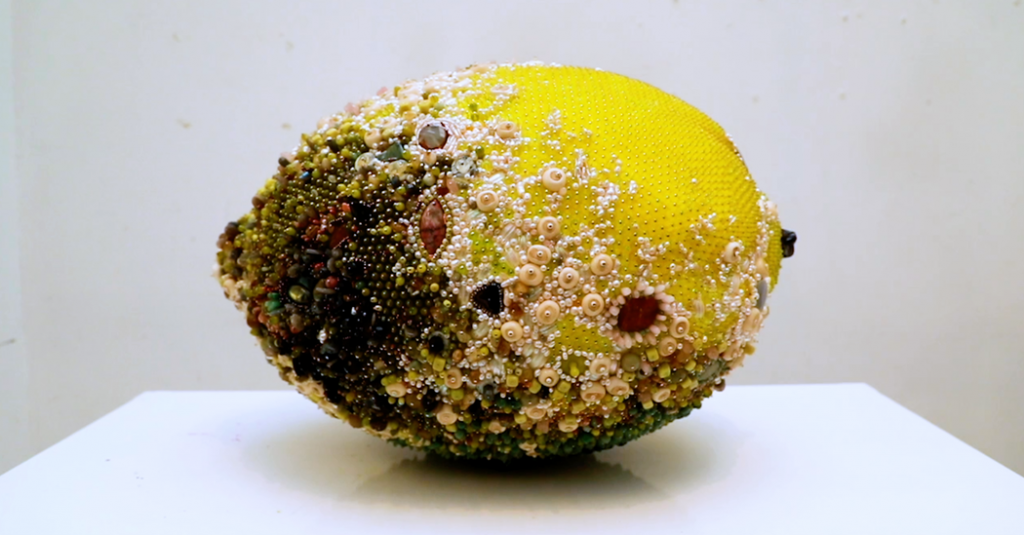
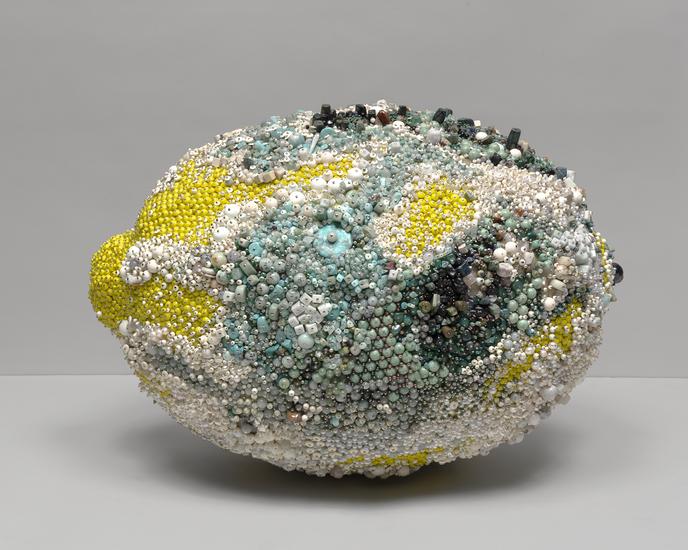

This is the original church that was in Biggin Hill. As the area grew in size the church needed to be extended and so they replaced it with a new one.
With limited funds, they decided to deconstruct a bomb damaged church in Peckham and move it brick by brick. The vicar Rev Vivian Symons got a lorry and worked to deconstruct the church. He soon gained a group of followers and volunteers.



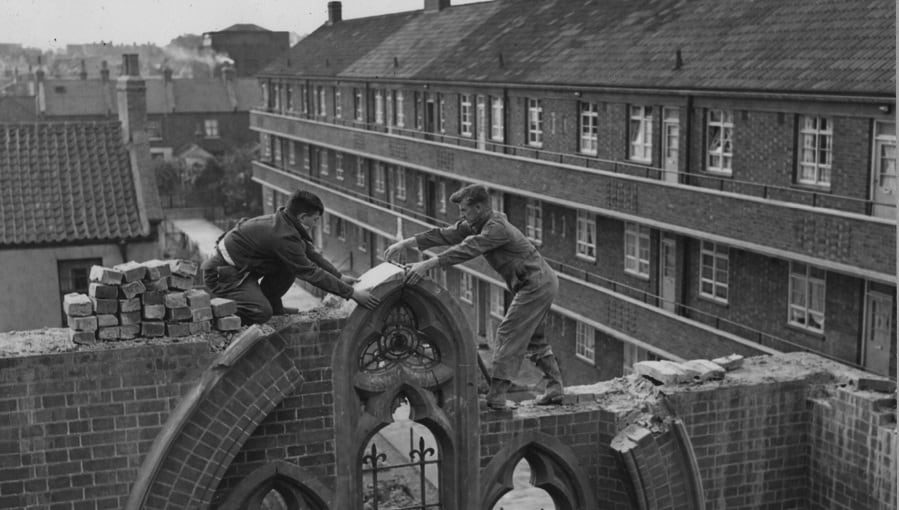
The deconstruction took three years, with a series of 125,000 bricks, the timbers and stonework, they hired Giles Gilbert Scott to design something new, with the remit of their limited resources.

The old window frames were taken and re-carved to make details for the bell tower. The timbers were recycled as seen in the picture below.
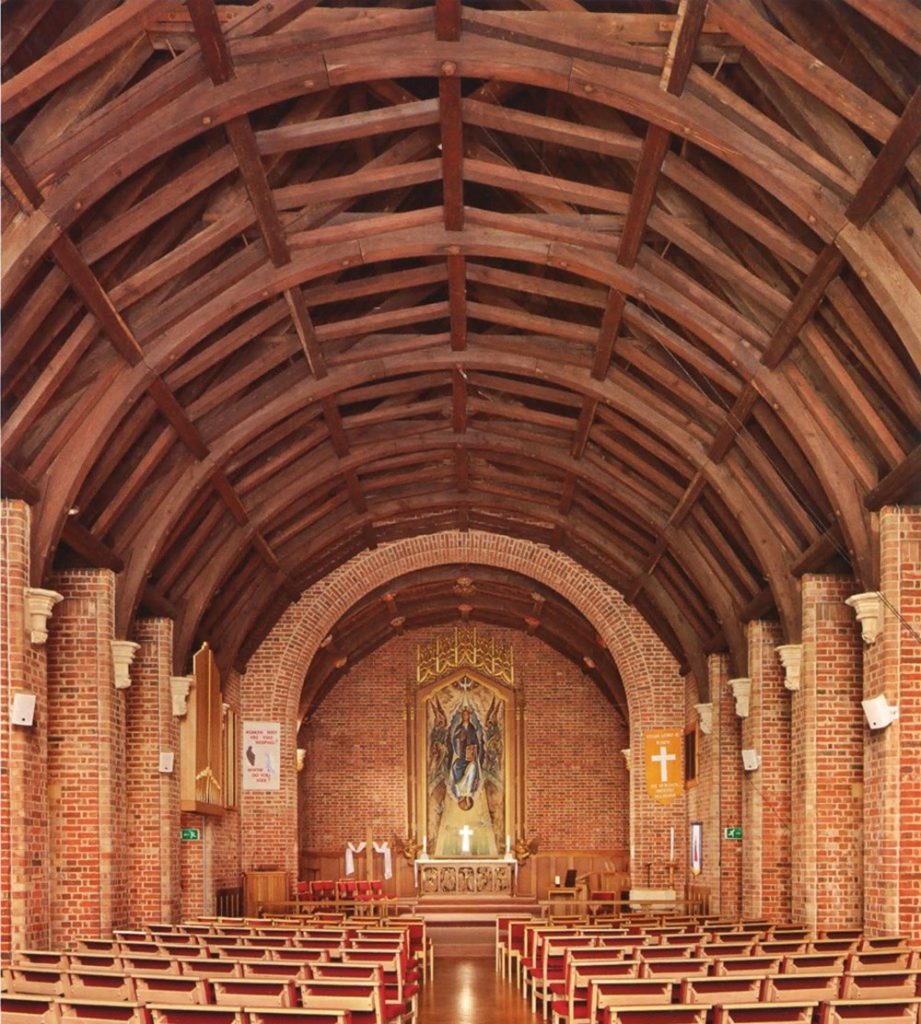
Other than new fittings of chairs, they also commissioned a new altar painting from Roland Pym, who is best known for his pop up book on Cinderella.
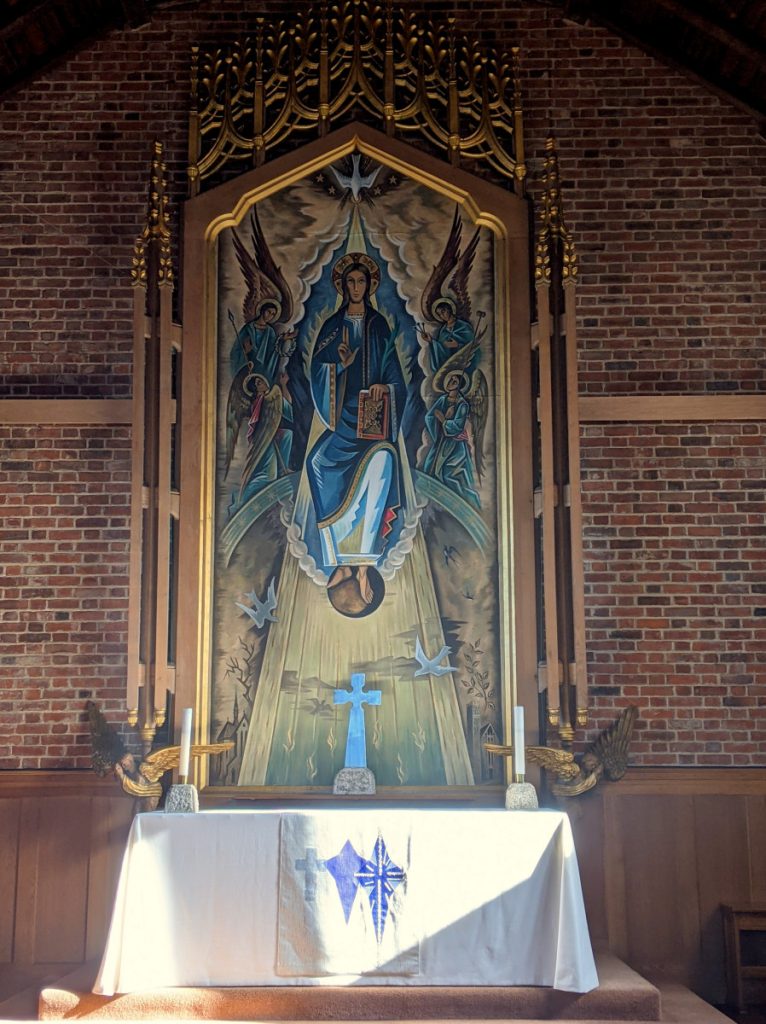
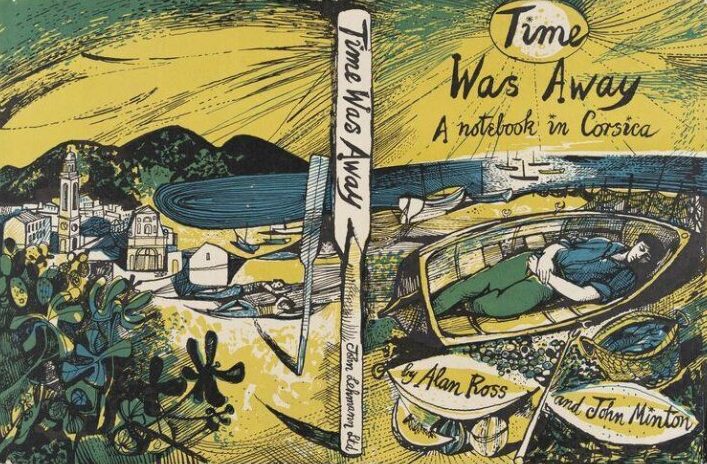
One of the aspects of printmaking that I love is how a work is layered and composed. This post focuses on John Minton’s design for the dust jacket of Time Was Away by Alan Ross. Minton’s paintings are bright and colourful and as a commercial artist he was known for his Neo-romantic drawings and scratchy ink style.
The colour layers of this cover are made up of three inks, a yellow, a blue and black, with the first two being layered to make green and save money with the printing process.
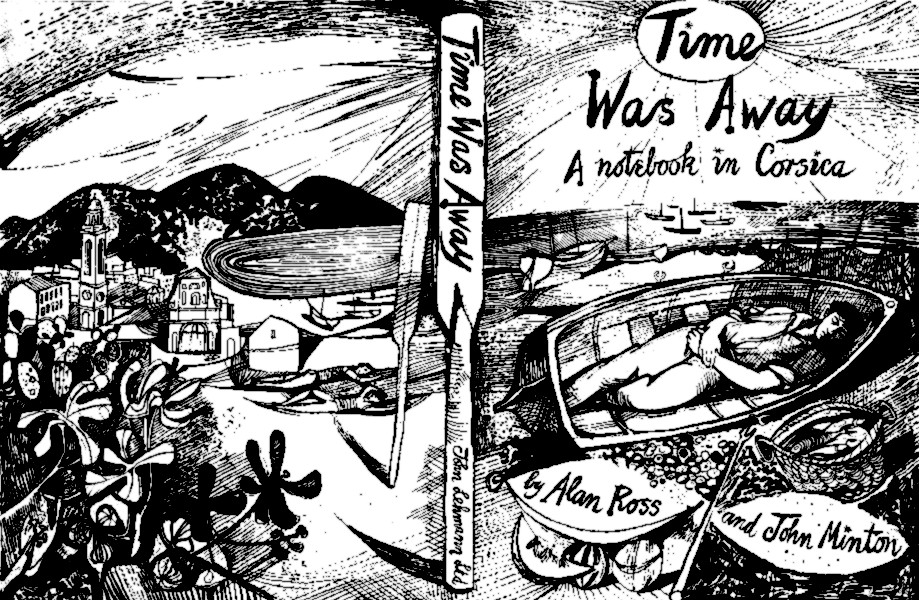
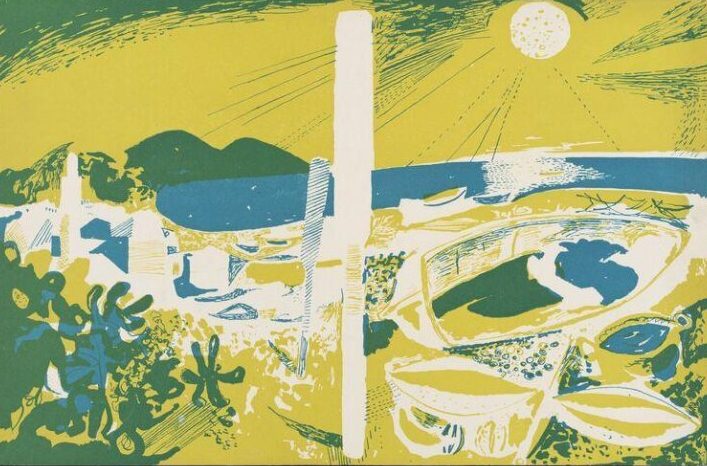
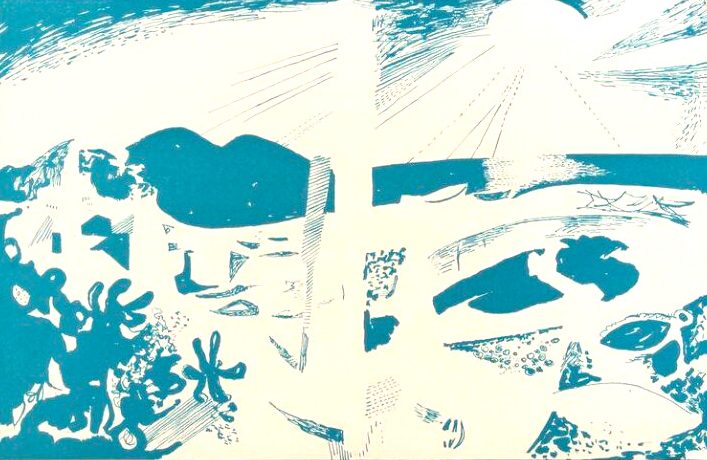
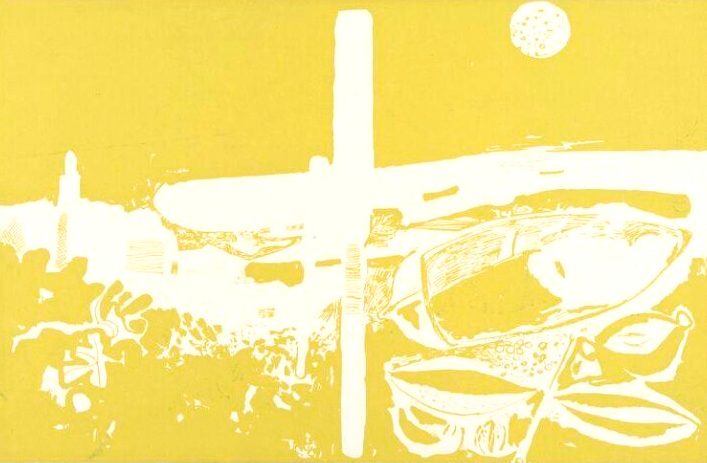
This is a movie that is rather hard to come by, but has made it way on to youtube. It was suggested to me by a friend and it is remarkably camp but good in my view.
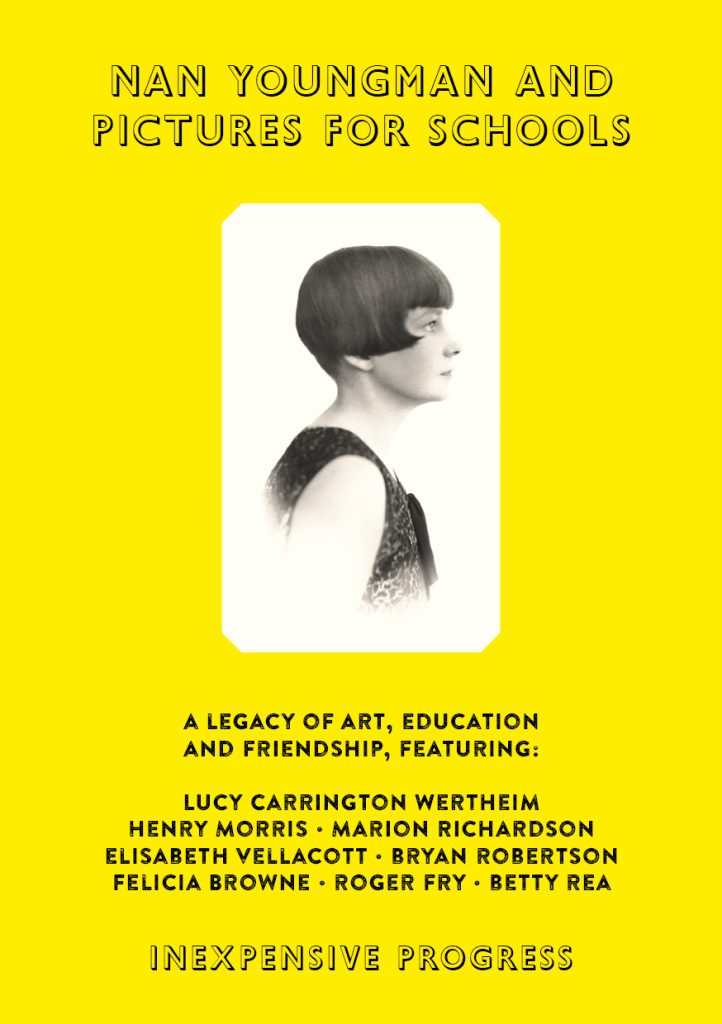
25th June 2025, 6.30pm – 8.30pm
Cost £10 per person (£12 with donation)
Venue Studio Space at David Parr House
Book via the David Parr House website
Join Robjn Cantus for a salon talk exploring the remarkable life and legacy of Nan Youngman, an artist, educator and key contributor to Cambridge’s mid-20th-century cultural identity.
Nan Youngman was an artist who lived most of her life in Cambridge. Together with her partner, Betty Rea they had moved to Huntingdon during the war, originally living in a caravan and then later, moving to Godmanchester and then Papermills, by the Leper Chapel on Newmarket Road.
She was a bold educator who strived to change the perception of art in schools from a pastime into a necessity. She worked for Henry Morris the pioneer of the Village College and who had employed Bauhaus architect Walter Gropius and his business partner Maxwell Fry to design Impington Village College.
Nan Youngman founded Pictures for Schools, a series of exhibitions were the counties of England were invited to buy paintings by the best artists in Britain, and later on prints. These works would then be hung in schools to inspire children and worked in with other lessons on education.
In Cambridge they met and had many connections, with friends like Tirzah Garwood, Elisabeth Vellacott, Lucy Carrington Wertheim and Bryan Robertson, who ran the gallery at Heffers bookshop for a time. It was due to Robertson’s intervention that Nan and her friends set up the Cambridge Society of Painters and Sculptors.
Together with many more people, they helped make Cambridge a more artistic place in the 1950s, 60s and 70s.
Robjn Cantus is a writer, collector and researcher based on the edge of Cambridge. Robjn is known for his detailed work on 20th-century British art and artists. His published books include Nan Youngman & Pictures for Schools (forthcoming, 2025), Great Bardfield Illustrated: A Bibliographic List (2024), Looking at Life in an English Village: Edward Bawden & Great Bardfield (2022) and Before and After Great Bardfield (2021).
The talk will be followed by a Q&A, light refreshments and the chance to purchase a signed copy of Robjn’s new book at 10% discount on the night. Please note, by purchasing a copy of the book with your ticket you get a 15% discount on the book.
I should add I am doing this talk for free, so that all your donations do to the David Parr House.
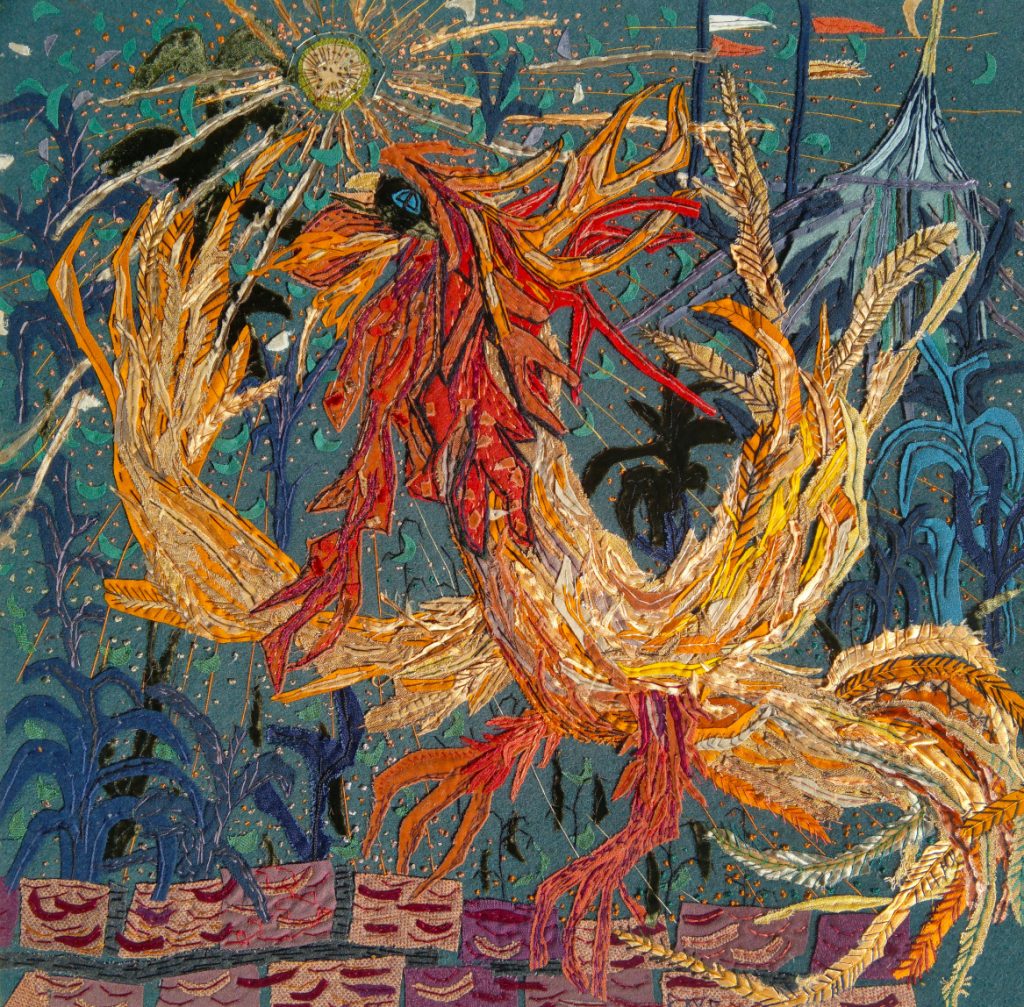
Margaret Kaye, in a professional career in glass and textiles between 1937 and 1985, executed commissions for windows in Chichester, in York, for the Boltons and Radnage, as well as for a mission in Formosa (now Taiwan). She also carried out stained-glass restorations for the National Trust during the 1930s; at Stourhead, in Wiltshire, on the late 14th-century window of the great hall at Rufford Old Hall, and at Penshurst, Aylesbury and Woburn, among other houses.
In the field of textiles, she established a highly personal and individual style in the making of hangings for domestic interiors. These were splendid in their rich colour and texture, combining appliqué, fabric collage, strands of thread, dyed lace and embroidery, in bold and inventive designs evoking the palette of artists like Georges Rouault or Antonio Clavé, who were among her favourites. The Victoria and Albert Museum have four such pieces in their collection, Lion in a Forest and Bull and Pigeons, both of 1949, and The Cat and the Owl and Pigeons, both of 1951.
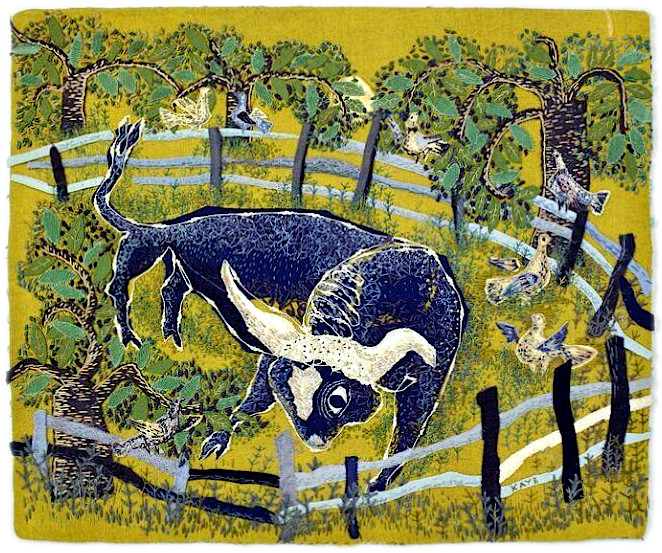
For a number of churches and cathedrals, she created altar frontals and copes. She executed ecclesiastical furnishings for Marlborough College Chapel, and for Winchester, York and Chichester Cathedrals, as well as for many English churches and chapels. One of her major commissions was that for the Queen’s personal gift to the cathedral in Accra, Ghana.
Margaret Kaye was born in 1912, and was first trained at Croydon School of Art, then attended the Royal College, specialising in fabric collage and stained glass, which she was taught by the celebrated Martin Travers. Later married to Reece Pemberton, the stage designer, and always herself passionate about the theatre, she designed accessories for ballets for Marie Rambert at Sadler’s Wells.
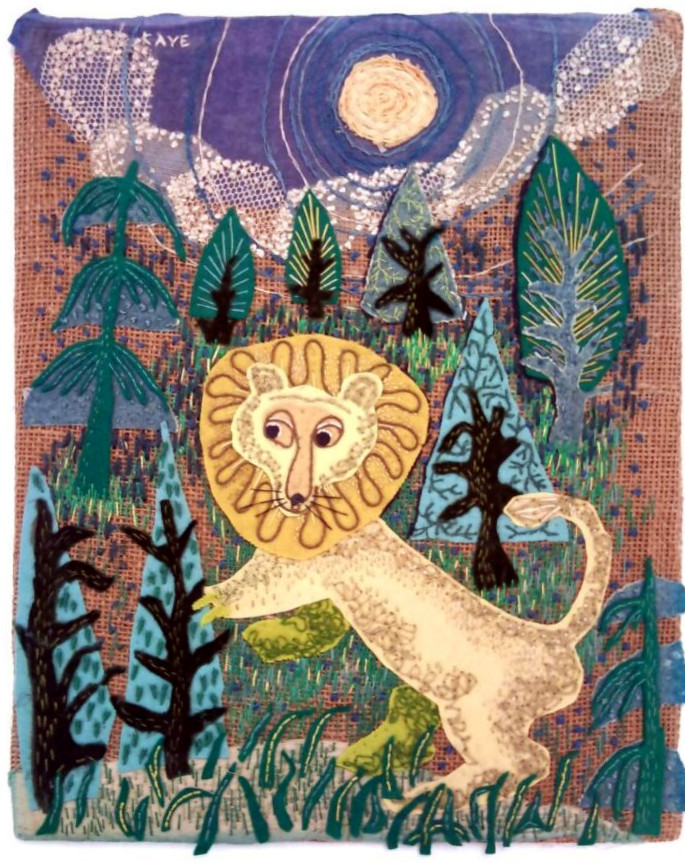
A new development during the 1940s was her activity as a painter. In many ways, her approach to fine art was related to her textiles. For her collage pictures, which were highly abstracted but suggested landscape, she used found objects, pieces of cork, leaf and bark, bits of fabric, cardboard and torn photographs, modifying them with watercolour or gouache, always with a rich and warm colour sense, characteristically in browns, ochres, creams and reds. Her work attracted the attention of Sir Kenneth (later Lord) Clark, who introduced her to the art dealer Henry Roland, and from 1949 to 1977 she had regular solo exhibitions at Roland, Browse and Delbanco in Cork Street.
Having acquired a weekend house on the edge of Tilford Common in Surrey in 1955, she and her husband moved there from Hammersmith shortly before he died in 1977. From 1976 to 1989 Kaye had four exhibitions at the New Ashgate Gallery in Farnham. Her collages were exhibited widely in mixed shows in Britain, the US, Australia and South Africa. Her work is in many public collections including those of the Contemporary Art Society and Manchester City Art Gallery.
Kaye taught full-time for a period at Birmingham College of Art, then, in London during the 1960s and 1970s, part-time at Camberwell and St Martin’s. Her former pupils remember her as “a wonderful teacher, always on the side of the students”. Having no children of her own, she valued her association with young talented people. In her later years she gave a Travelling Prize annually in Fine Art or Textiles to students at West Surrey College of Art.